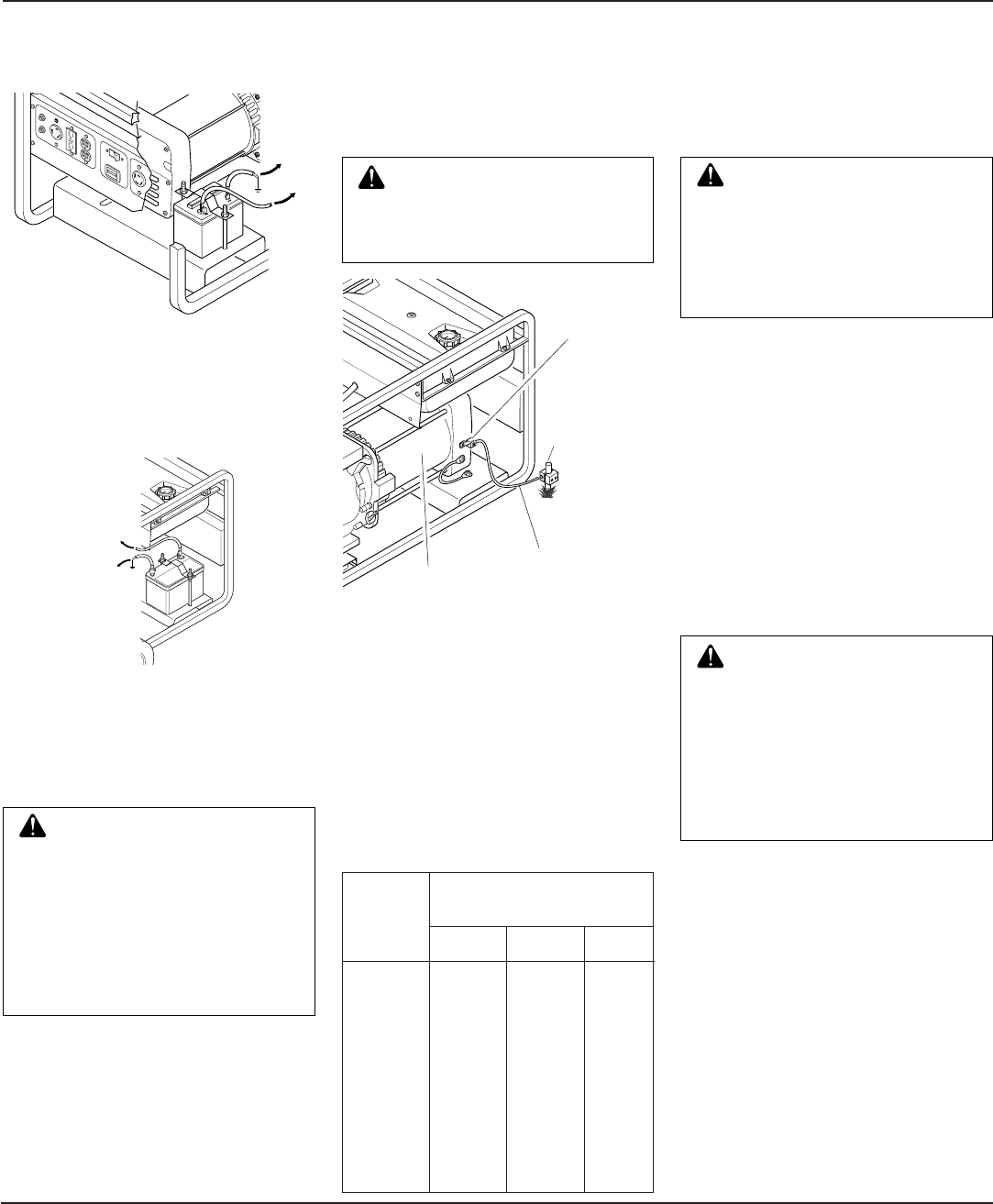
9
105420
OWNER’S MANUAL
Ampere AWG for Length of
Load Cord in Feet
50' 100' 150'
2181818
3181818
4161616
5161616
6161614
8161412
10 16 14 12
12 14 14 12
14 14 12 10
16 12 12 10
20 10 10 8
FUEL
F
TO STARTER
SOLENOID
TO ENGINE
BLOCK
120
O
NLY
120
240V
ENM
00000005
H
OU
R
S 1/10
FU
LL PO
WER
Figure 12 - Connecting Positive and
Negative Cables to Battery (Model
MGH7000C Shown)
BATTERY
Continued
F
U
E
L
F
Figure 13 - Connecting Positive and
Negative Cables to Battery (Model
MGH10000 Shown)
TO
STARTER
SOLENOID
TO
ENGINE
BLOCK
GENERATOR
GROUNDING
Ground Lug
Ground Wire
Alternator
Copper or
Brass
Grounding
Point
Figure 14 - Grounding Generator
(Model MGH4000C Shown)
EXTENSION
CORDS
Only use grounded extension cords. Be sure
to use extension cord with proper wire gauge
size. See chart below.
Recommended Minimum Wire
Gauges (AWG) for Extension
Cords
WARNING: For a grounding
point, do not use metal pipe be-
ing used to carry combustible
materials or gases.
Grounding generator helps prevent electric
shock from a ground fault condition. Locate
ground lug on end of generator housing (see
Figure 12). Attach a #10 stranded-copper
ground wire to ground lug. Drive grounding
point into ground. Grounding point can be a
stake, grounding rod, or pipe. Grounding
point should be copper or brass. Attach
WARNING: You must prop-
erly earth-ground generator be-
fore starting. This will help guard
against deadly electric shock.
Only use grounded plugs with
generator. Only use grounded ex-
tension cords. Only use three-
wire or double-insulated power
tools.
ground wire to grounding point. You must
supply the ground wire and grounding point.
These do not come with generator. Follow
the National Electrical Code and all state
and local codes. Consult your power com-
pany or a licensed electrician.
STANDBY
INSTALLATION TO
HOME OR
BUILDING
DETERMINING
ELECTRICAL LOAD
FOR GENERATOR
You must decide what electrical load your
generator can power. Do this before using
generator. Use the following four-step
method. It will help you select a load that is
not too large. Make sure total wattage of all
electrical loads does not exceed rated watt-
age of generator. For rated wattage of your
generator, see Specifications, page 5. Elec-
tric motors present a special problem when
figuring load. Read Step 3 carefully.
WARNING: The electrician
must install a double-throw trans-
fer switch. This isolates existing
electrical circuits from the utility
power line. If not isolated, gen-
erator output will back-feed into
utility power line. This may elec-
trocute a power company line
repair person.
IMPORTANT:
This generator will not
power your entire home. Most home utility
electric service is more than 60 amps. This
will exceed generator output. Only power
needed items during a power outage. Make
sure total wattage of electrical load does not
exceed rated wattage of generator.
You may need to use this generator as a
standby power source. During a power out-
age, the generator will power selected items
in a building. Have generator and additional
wiring installed by a skilled, licensed elec-
trician. This is not a do-it-yourself job. Fol-
low all local codes.
WARNING: Have standby in-
stallation performed by a skilled,
licensed electrician. Do not let
anyone else wire into a utility
circuit. Personal injury, equip-
ment damage, or damage to home
could occur.
Continued
